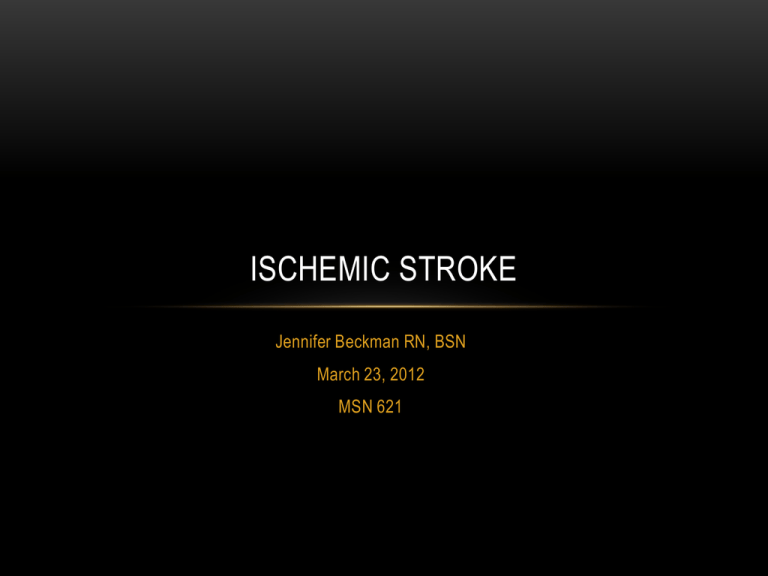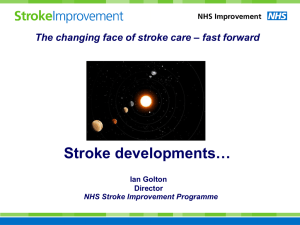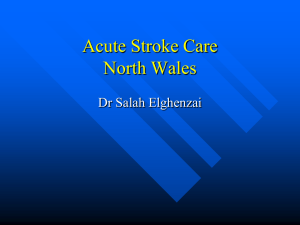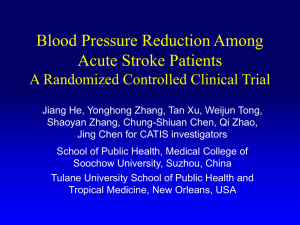
ISCHEMIC STROKE
Jennifer Beckman RN, BSN
March 23, 2012
MSN 621
ISCHEMIC STROKE CASE STUDY
T.H. is a 70 y/o female and enjoying lunch with with her daughter.
During lunch her daughter notices T.H. is unable to grasp the fork
properly in her right hand. She has developed a right facial droop.
Her daughter asked if she was feeling okay and T.H. could not
remember who her daughter was. 911 was initiated and arrived
within 10 minutes.
ISCHEMIC STROKE OUTCOMES
-
Define Ischemic Stroke
-
Understand Pathophysiology
-
Explain signs and symptoms
-
Outline treatment options
WHAT IS ISCHEMIC STROKE?
- Blocked artery in the brain
- Brain depends on arteries to
bring fresh blood from heart
and lungs
- Blood carries oxygen and
nutrients to the brain, and
takes away carbon dioxide
and cellular waste
- When an artery is blocked,
brain cells cannot make
enough energy and will stop
working
- If an artery remains blocked
for more than a few minutes,
brain cells may die
- Immediate medical treatment
is vital
The Internet Stroke Center. (n.d.). Retrieved February 7, 2012, from Ischemic Stroke: http://www.strokecenter.org/patients/about-stroke/ischemic-stroke/ Used with permission.
ISCHEMIC STROKE ANIMATION
National Stroke Association. (2012). Retrieved February 7, 2012, from Types of Stroke: http://www.stroke.org/site/PageServer?pagename=TYPE Used
with permission.
GENERAL BRAIN FUNCTION
-
What two products below does blood carry away from the brain?
PATHOPHYSIOLOGY OF ISCHEMIC STROKE
- Extent of damage depends on severity of
ischemia
- Inflammatory mediators IL-1B and TNF- α
contribute to edema and microvascular
thrombosis
- CT scan slice of the brain showing a
right-hemispheric stroke
- Neurons die when perfusion is < 5% of
normal for > 5 min
Wikipedia. (2012, March 29). Stroke. Retrieved March 30, 2012, from Wikipedia:
http://en.wikipedia.org/wiki/Ischemic_stroke#Ischemic Image used with permission
from Wikimedia Commons.
Elias A. Giraldo, M. (2007, April). Ischemic Stroke. Retrieved February 7, 2012, from The Merk Manual:
http://www.merckmanuals.com/professional/neurologic_disorders/stroke_cva/ischemic_stroke.html
- Edema may increase intracranial pressure if
severe
- Increased pressure will deprive brain
cells of oxygen
- May damage brain cells if edema
persists
PATHOPHYSIOLOGY OF ISCHEMIC STROKE
Apoptosis Diagram
- Promptly restoring blood flow may reduce or
reverse injury
- Mechanisms of ischemic injury include: edema,
microvascular thrombosis, apoptosis (programmed
cell death), infarction with cell necrosis
- Damage occurs more rapidly during hyperthermia
and more slowly during hypothermia
Elias A. Giraldo, M. (2007, April). Ischemic Stroke. Retrieved February 7, 2012, from The Merk Manual:
http://www.merckmanuals.com/professional/neurologic_disorders/stroke_cva/ischemic_stroke.html
Wikipedia. (2012, March 29). Stroke. Retrieved March 30, 2012, from Wikipedia:
http://en.wikipedia.org/wiki/File:Apoptosis.png Image used with permission from
Wikimedia Commons
ISCHEMIC INJURY CASCADE
Lack of O2 causes neuron's process for making ATP for energy fail
↓
Cells switch to anaerobic metabolism, producing lactic acid
↓
ATP-reliant ion transport pumps fail, causing cell to become depolarized, allowing ions, including Ca ++, to flow into the cell
↓
The ion pumps can’t transport Ca ++ out of the cell, intracellular calcium levels get too high
↓
Ca ++ triggers release of glutamate, an excitatory amino acid neurotransmitter
↓
Glutamate stimulates AMPA receptors and Ca ++-permeable NMDA receptors, which open to allow more Ca ++ into cells.
↓
Excess Ca ++ entry overexcites cells and causes the generation of harmful chemicals
↓
Cell's membrane is broken down by phospholipases, becomes more permeable, and more ions and harmful chemicals flow into the
cell
↓
Mitochondria break down, releasing toxins and apoptotic factors into the cell
↓
As cells die through necrosis, it releases glutamate and toxic chemicals into environment. Toxins poison nearby neurons, and
glutamate can overexcite them.
Wikipedia. (2012, February 1). Ischemic cascade. Retrieved April 13, 2012, from Wikipedia: http://en.wikipedia.org/wiki/Ischemic_cascade
PATHOPHYSIOLOGY OF ISCHEMIC STROKE
-
What is a mechanism that can cause ischemic injury?
Signs and Symptoms of Ischemic Stroke
- Sudden numbness of the face, arm, or
leg, especially on one side of the body
- Sudden confusion, trouble speaking or
understanding speech
-
Sudden trouble seeing in one or both eyes
- Sudden trouble walking, dizziness, loss of
balance or coordination
- Sudden severe headache with no known
cause
Jones, K. (2012, February 4). Med India Network for Health. Retrieved
February 15, 2012, from Risk of Ischemic Stroke may be Aggravated by
Infections in Childhood: http://www.medindia.net/news/risk-of-ischemicstroke-may-be-aggravated-by-infections-in-childhood-97035-1.htm Used
with permission.
The Internet Stroke Center. (n.d.). Retrieved February 7, 2012, from Ischemic Stroke: http://www.strokecenter.org/patients/about-stroke/ischemic-stroke/
TREATMENT OPTIONS FOR ISCHEMIC
STROKE
- Thrombolytic (Fibrinolytic) Drugs
- Tissue Plasminogen Activator (tPA)
is given intravenously to break up
clots and help restore blood flow to
the brain
- Antiplatelet Drugs and Anticoagulants
- ASA, Heparin, Warfarin
- The figure to the right demonstrates
clot fibrinolysis. Blue arrows denoting
stimulation, and red arrows inhibition.
File: Fibrinoysis.png. (2005, April 26). Retrieved February 19, 2012, from Wikipedia The Free Encyclopedia:
http://en.wikipedia.org/wiki/File:Fibrinolysis.png Used with permission.
Elias A. Giraldo, M. (2007, April). Ischemic Stroke. Retrieved February 7, 2012, from The Merk Manual:
http://www.merckmanuals.com/professional/neurologic_disorders/stroke_cva/ischemic_stroke.html
TREATMENT OPTIONS FOR ISCHEMIC
STROKE
-
Surgery
- Carotid Endarterectomy
-
Stents
- Completed if Endarterectomy
is too risky
-
Other Treatments
- Tiny corkscrew-shaped device
or vacuum used to snag clot
and remove it
National Stroke Association. (2012). Retrieved February 7, 2012, from Types of Stroke: (Shaping the Future of Aneurysm
Treatments, 2008) Used with permission.
Elias A. Giraldo, M. (2007, April). Ischemic Stroke. Retrieved February 7, 2012, from The Merk Manual:
http://www.merckmanuals.com/professional/neurologic_disorders/stroke_cva/ischemic_stroke.html
TREATMENT OPTIONS FOR ISCHEMIC
STROKE
- What of the following are examples of invasive treatment
options for Ischemic Stroke.
SUMMARY OF ISCHEMIC STROKE
-
Define Ischemic Stroke:
Angiogram 3D Reconstruction Showing Area
of Intracranial Arterial Blockage
- A blocked artery in the brain
- Brain is unable to receive oxygen
-
Understand Pathophysiology:
- Mechanism of injury: edema,
microvascular thrombosis, apoptosis,
infarction with cell necrosis
- Neurons die without oxygen
-
Outline treatment options:
- Medications, surgery, stents
-
Explain signs and symptoms:
- Numbness, headache, confusion,
trouble seeing and walking
Treating Acute Ischemic Stroke. (n.d.). Retrieved February 19, 2012, from The University Hospital:
http://www.theuniversityhospital.com/stroke/ischemic.htm Used with permission from Charles Prestigiacomo, MD,
Chair, Department of Neurosurgery, UMDNJ-University Hospital
LITERATURE CITED
- Elias A. Giraldo, M. (2007, April). Ischemic Stroke. Retrieved February 7, 2012, from The Merk Manual:
http://www.merckmanuals.com/professional/neurologic_disorders/stroke_cva/ischemic_stroke.html
- File: Fibrinoysis.png. (2005, April 26). Retrieved February 19, 2012, from Wikipedia The Free Encyclopedia:
http://en.wikipedia.org/wiki/File:Fibrinolysis.png
- Jones, K. (2012, February 4). Med India Network for Health. Retrieved February 15, 2012, from Risk of Ischemic Stroke may be
Aggravated by Infections in Childhood: http://www.medindia.net/news/risk-of-ischemic-stroke-may-be-aggravated-by-infections-inchildhood-97035-1.htm
- National Stroke Association. (2012). Retrieved February 7, 2012, from Types of Stroke: Shaping the Future of Aneurysm
Treatments, 2008
- The Internet Stroke Center. (n.d.). Retrieved February 7, 2012, from Ischemic Stroke: http://www.strokecenter.org/patients/aboutstroke/ischemic-stroke/
- Treating Acute Ischemic Stroke. (n.d.). Retrieved February 19, 2012, from The University Hospital:
http://www.theuniversityhospital.com/stroke/ischemic.htm
- National Stroke Association. (2012). Retrieved February 7, 2012, from Types of Stroke:
http://www.stroke.org/site/PageServer?pagename=TYPE
- Wikipedia. (2012, February 1). Ischemic cascade. Retrieved April 13, 2012, from Wikipedia:
http://en.wikipedia.org/wiki/Ischemic_cascade
- Wikipedia. (2012, March 29). Stroke. Retrieved March 30, 2012, from Wikipedia:
http://en.wikipedia.org/wiki/Ischemic_stroke#Ischemic
- Wikipedia. (2012, March 29). Stroke. Retrieved March 30, 2012, from Wikipedia: http://en.wikipedia.org/wiki/File:Apoptosis.png
Image used from Wikimedia Commons








